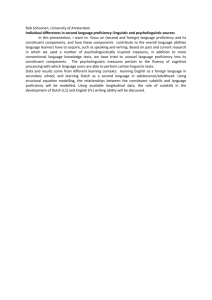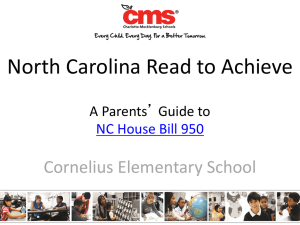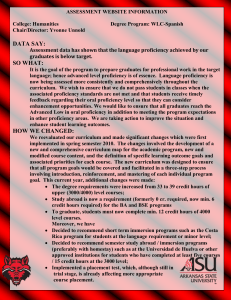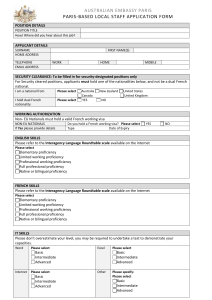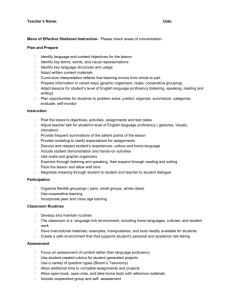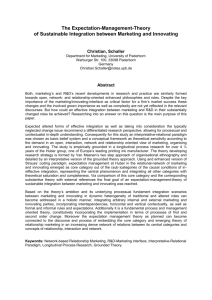SRG Teacher Development Tool
advertisement
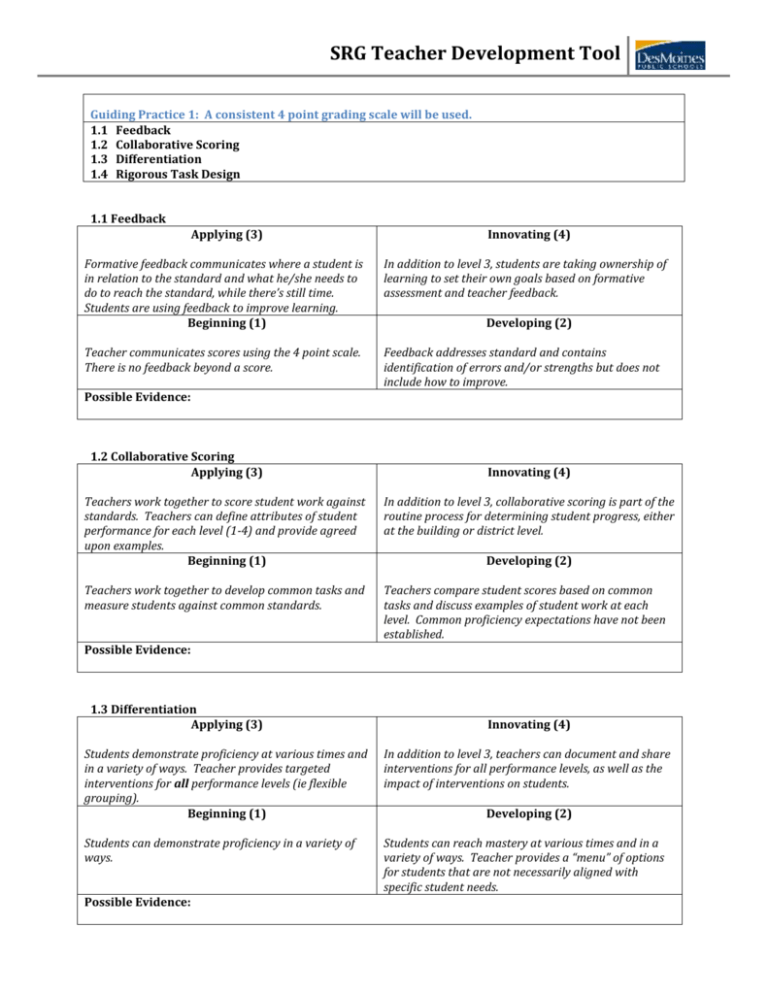
SRG Teacher Development Tool Guiding Practice 1: A consistent 4 point grading scale will be used. 1.1 Feedback 1.2 Collaborative Scoring 1.3 Differentiation 1.4 Rigorous Task Design 1.1 Feedback Applying (3) Innovating (4) Formative feedback communicates where a student is in relation to the standard and what he/she needs to do to reach the standard, while there’s still time. Students are using feedback to improve learning. Beginning (1) In addition to level 3, students are taking ownership of learning to set their own goals based on formative assessment and teacher feedback. Teacher communicates scores using the 4 point scale. There is no feedback beyond a score. Feedback addresses standard and contains identification of errors and/or strengths but does not include how to improve. Developing (2) Possible Evidence: 1.2 Collaborative Scoring Applying (3) Innovating (4) Teachers work together to score student work against standards. Teachers can define attributes of student performance for each level (1-4) and provide agreed upon examples. Beginning (1) In addition to level 3, collaborative scoring is part of the routine process for determining student progress, either at the building or district level. Teachers work together to develop common tasks and measure students against common standards. Teachers compare student scores based on common tasks and discuss examples of student work at each level. Common proficiency expectations have not been established. Developing (2) Possible Evidence: 1.3 Differentiation Applying (3) Innovating (4) Students demonstrate proficiency at various times and in a variety of ways. Teacher provides targeted interventions for all performance levels (ie flexible grouping). Beginning (1) In addition to level 3, teachers can document and share interventions for all performance levels, as well as the impact of interventions on students. Students can demonstrate proficiency in a variety of ways. Students can reach mastery at various times and in a variety of ways. Teacher provides a “menu” of options for students that are not necessarily aligned with specific student needs. Possible Evidence: Developing (2) SRG Teacher Development Tool 1.4 Rigorous Task Design Applying (3) Innovating (4) The teacher works collaboratively to design level 3 instructional tasks that reflect the rigor of the standard. Level 4 tasks are more cognitively demanding than level 3, have real-world connections, and have an authentic purpose. Beginning (1) In addition to level 3, teachers allow students to create aligned tasks to demonstrate their learning at the different proficiency levels. Instructional tasks align to standards but do not align to levels of proficiency in academic scales. Possible Evidence: The teacher works collaboratively to design level 3 and 4 tasks that align to curriculum scales. Developing (2) Guiding Practice 2: Letter grades, derived from the 4-point scale, will be based solely on achievement of course/grade level standards. Student participation, work completion, and ability to work with others will be reported separately using the ‘DMPS Citizenship and Employability Skills Rubric’. 2.1 Alignment of Student Performance to Academic Scales 2.2 Separating Academic and Non-academic Performance 2.1 Alignment of Student Performance to Academic Scales Applying (3) Innovating (4) Each piece of student evidence is directly aligned to component(s) for both content and level of student performance expected in the scales. Beginning (1) In addition to level 3, student performance expectations include application and transfer to authentic situations applicable beyond the classroom. Developing (2) Alignment of student evidence and the corresponding academic standard(s) is loose (i.e. student evidence is in the subject of the standard, but does not meet the defined intention of the standard). Possible Evidence: Student evidence is directly aligned to component(s) in the scales inconsistently. 2.2 Separating Academic and Non-academic Performance Applying (3) Innovating (4) All topic scores and grades are based on student performance on academic standards only. Behaviors are captured on the DMPS Citizenship and Employability Skills Rubric and communicated accordingly. Beginning (1) In addition to level 3, a system using concrete data points is utilized to assign scores and give feedback based on the skills rubric. Academic grades are significantly impacted by data based on student behaviors. Academic grades are somewhat impacted by data based on student behaviors. Possible Evidence: Developing (2) SRG Teacher Development Tool Guiding Practice 3: Grades will be based on a body of evidence. 3.1 Celebrating Growth 3.2 Professional Judgment 3.3 Homework as Practice 3.1 Celebrating Growth* Applying (3) Innovating (4) Teacher informs students of their current status and their knowledge gain relative to the learning goal and connects students with opportunities to demonstrate learning at the next level. Beginning (1) In addition to level 3, teacher creates an environment where students actively seek opportunities to demonstrate their learning at higher levels. Teacher feedback is not connected to the learning goal. Teacher informs students of their current status and their knowledge gain relative to the learning goal. Developing (2) Possible Evidence: 3.2 Professional Judgment Applying (3) Body of evidence is viewed holistically, considering student growth as demonstrated by their performance. Beginning (1) Teacher bases final topic score on a few pieces of evidence (such as a final exam). Possible Evidence: 3.3 Homework as Practice* Applying (3) Innovating (4) In addition to level 3, teacher creates an environment where students participate in determining final topic scores based on evidence. Developing (2) Teacher bases final topic score based solely on most recent evidence of learning. Innovating (4) When appropriate, the teacher assigns homework that is designed to deepen knowledge of information or practice a skill, strategy, or process and the teacher monitors the extent to which students understand the homework. Beginning (1) In addition to level 3, teacher differentiates the homework based on unique student needs and situations. Homework is assigned with little to no alignment to standards and/or homework is assigned prematurely with respect to instruction provided. When appropriate, the teacher assigns homework that is designed to deepen knowledge of information or practice a skill, strategy, or process. Developing (2) Possible Evidence: Guiding Practice 4: Achievement will be organized and reported by standard/learner objective, which will be converted to a grade. 4.1 Tracking Progress 4.2 Communicating Progress SRG Teacher Development Tool 4.1 Tracking Progress* Applying (3) Innovating (4) Teacher facilitates documenting of student progress in IC and monitors the extent to which students understand their level of performance within a standard/learner objective. Beginning (1) In addition to level 3, the teacher adapts and creates new strategies for unique student needs and situations, including students monitoring and understanding their own progress. Developing (2) Teacher facilitates documenting of student progress by standard/learner objective. Teacher facilitates documenting of student progress by standard/learner objective and uses IC to communicate with students and parents. Possible Evidence: 4.2 Communicating Progress Applying (3) In addition to level 2, Infinite Campus is updated in a timely manner (and according to building expectations). Beginning (1) Teacher uses IC incorrectly or with missing evidence. Innovating (4) In addition to level 3, the teacher communicates with stakeholders in a variety of ways and on a more frequent basis. The teacher communicates through a variety of tools, including features in IC to increase understanding of student progress. Developing (2) Teacher organizes and reports to all stakeholders evidence of student learning using pre-established learning topics aligned to the course standards and using a four-point scale. Possible Evidence: Guiding Practice 5: Students will have multiple opportunities to demonstrate proficiency. 5.1 Multiple and Varied Ways to Demonstrate Proficiency 5.2 Redos/Retakes and Flexible Timelines 5.1 Multiple and Varied Opportunities to Demonstrate Proficiency Applying (3) Innovating (4) Students have multiple opportunities to demonstrate proficiency through a variety of tasks. Students submit a minimum of two pieces of evidence per topic. Teachers use multiple pieces of evidence to make an informed decision regarding a student’s level of proficiency. Beginning (1) In addition to level 3, students demonstrate proficiency through a variety of student designed tasks. Students have voice and choice in the task. Students are advocating for themselves—finding real-world connections and applications. Students submit evidence for each topic. A variety of opportunities is not offered. Students submit evidence for each topic. Multiple opportunities to demonstrate proficiency are offered inconsistently. Possible Evidence: Developing (2) SRG Teacher Development Tool 5.2 Redos/Retakes and Flexible Timelines Applying (3) Innovating (4) Using teacher feedback to improve learning, students resubmit evidence to demonstrate new learning and proficiency until the established deadline for posting grades. Beginning (1) In addition to level 3, teachers require students to retake/redo assessments and evidence to reach or exceed proficiency. A limited number of opportunities are provided for students to demonstrate proficiency. Students resubmit evidence to demonstrate new learning and proficiency until the established deadline for posting grades. Developing (2) Possible Evidence: Guiding Practice 6: Accommodations and/or modifications will be provided to students with special needs. TBD


